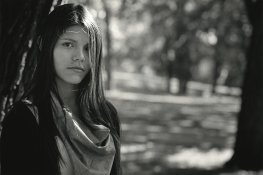darkroommike
Subscriber
Describing negatives with terms like thick, dense, thin, etc. can be rather ambiguous. I prefer to describe negatives with terms like high contrast, low contrast, and normally use ISO 400 materials at a lower ISO when using a TTL meter so that I get adequate shadow density (hey it works for me).
I try to expose my negatives so that my contact prints from my medium and large format negatives look good when printed with #2 contrast and that my 35mm negative contact sheets look good when printed with #3 contrast (35mm negatives are processed to a little lower contrast). Contact sheets for most negative materials require exposures between 15 and 30 seconds when exposed at f/11.
I print with a diffusion head on an Omega D5 (currently a Multigrade 600 head). I sometimes burn in skies with a higher contrast setting and will sometimes go into the shadows with a little extra low contrast exposure. I have even dodged shadows with a dodger made from a bit of CC30Y on a wire. But it's got to be a damn good shot of a unique event before I'll go further than that (think Elvis leaving on a UFO unique).
I try to expose my negatives so that my contact prints from my medium and large format negatives look good when printed with #2 contrast and that my 35mm negative contact sheets look good when printed with #3 contrast (35mm negatives are processed to a little lower contrast). Contact sheets for most negative materials require exposures between 15 and 30 seconds when exposed at f/11.
I print with a diffusion head on an Omega D5 (currently a Multigrade 600 head). I sometimes burn in skies with a higher contrast setting and will sometimes go into the shadows with a little extra low contrast exposure. I have even dodged shadows with a dodger made from a bit of CC30Y on a wire. But it's got to be a damn good shot of a unique event before I'll go further than that (think Elvis leaving on a UFO unique).












